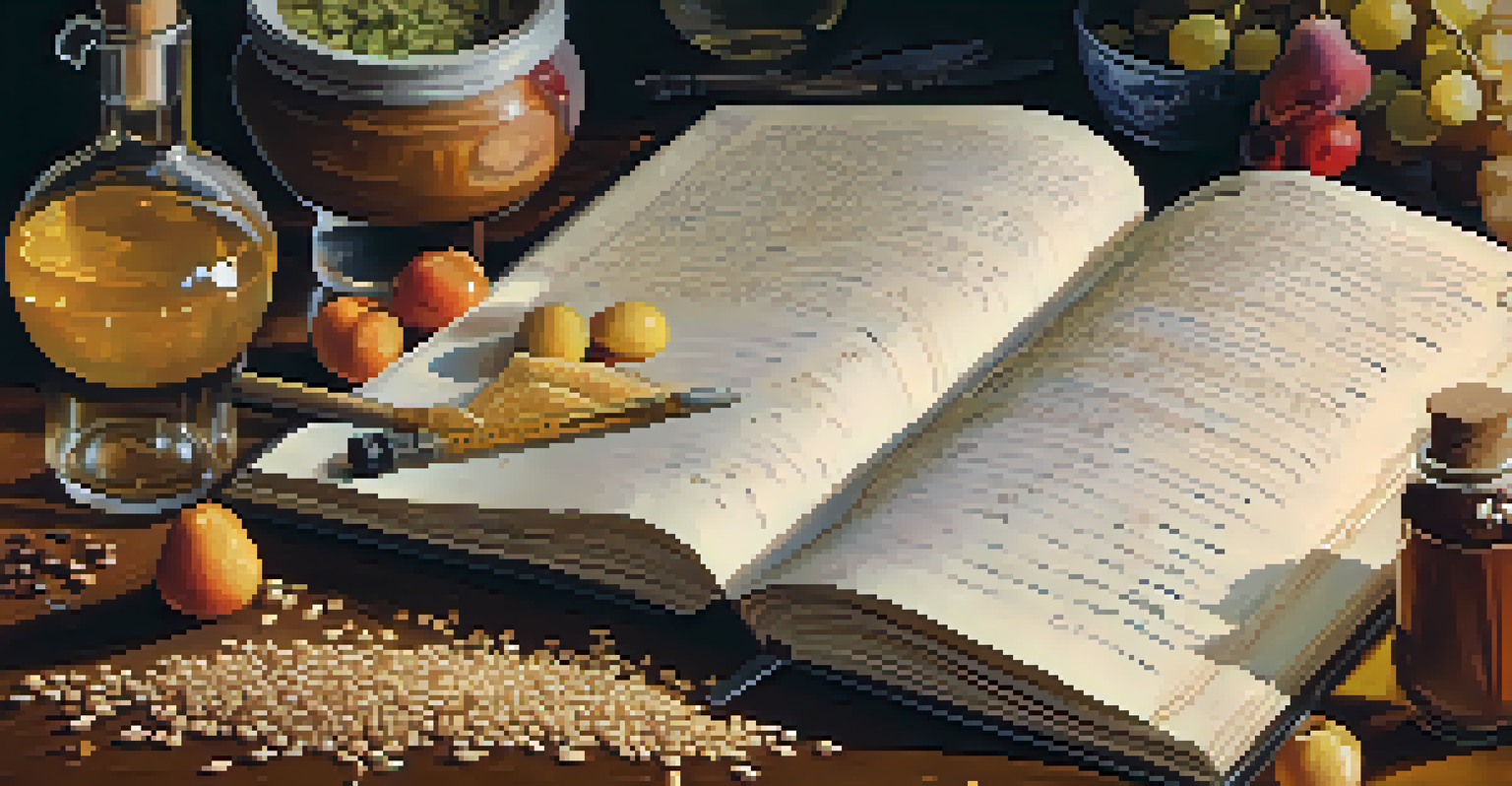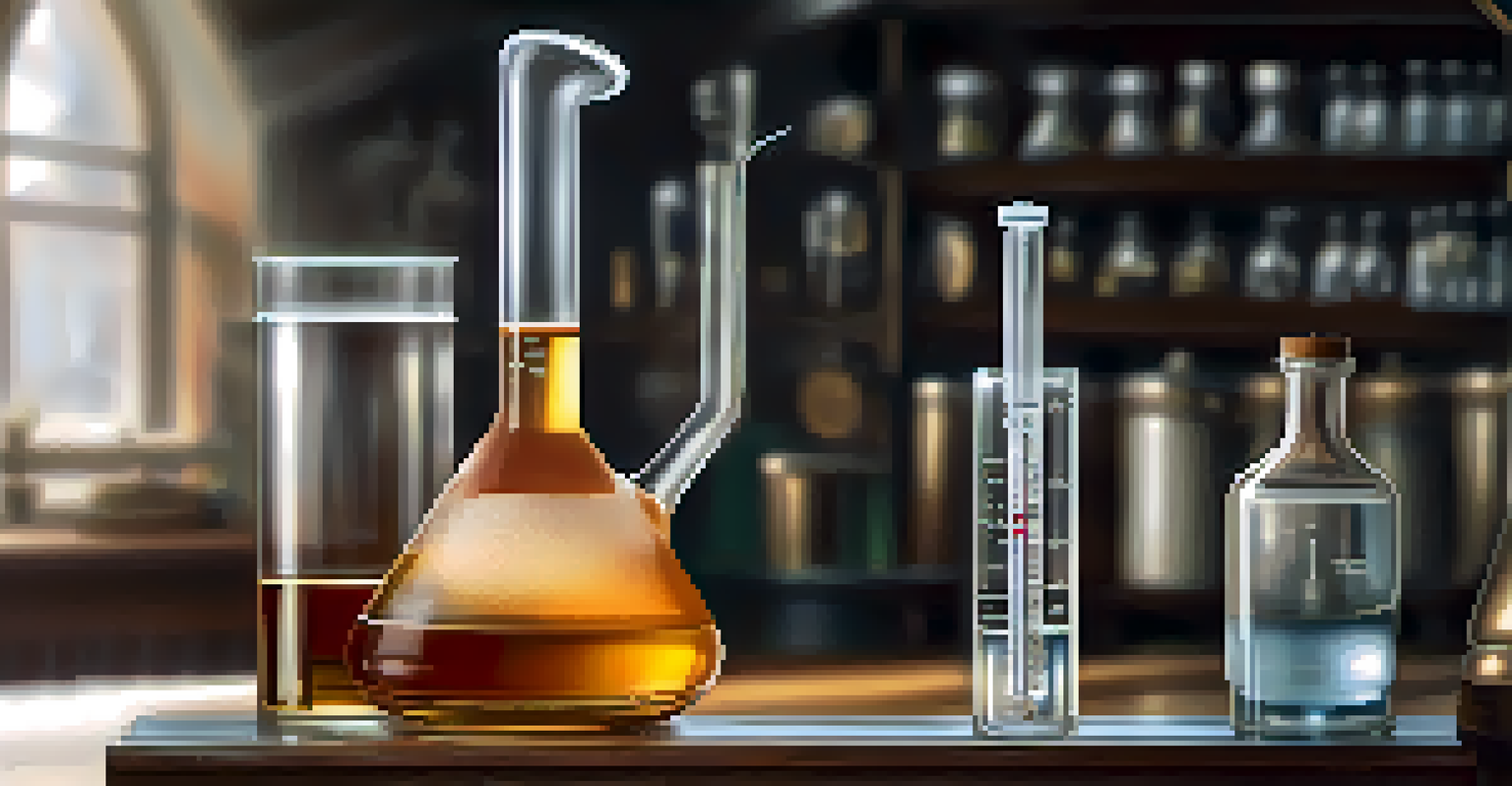Common Mistakes to Avoid When Home Distilling Spirits

Neglecting Safety Precautions is a Major Mistake
When it comes to home distilling, safety should always be your top priority. Using heat sources and alcohol can create hazardous situations if you’re not careful. Wearing safety goggles and gloves is essential, as well as ensuring your workspace is well-ventilated to prevent any buildup of harmful fumes.
Safety isn't just a set of rules; it's a mindset.
Additionally, it’s important to have a fire extinguisher nearby and know how to use it. Distilling alcohol can produce flammable vapors, and a small spark can quickly escalate. Never underestimate the power of preparation; a little safety awareness can go a long way in protecting you and your home.
Remember, distilling isn’t just a fun hobby; it comes with responsibility. By taking the necessary safety precautions, you can enjoy the process without putting yourself or others at risk.
Using Poor Quality Ingredients Can Ruin Spirits
The quality of your ingredients plays a crucial role in the final product. Using low-quality grains or fruits can lead to off-flavors that ruin the taste of your spirits. Think of it like cooking; using fresh, high-quality ingredients will yield a better dish, and the same goes for distilling.

Investing in quality ingredients not only enhances the flavor but can also make your distilling process smoother. For example, using organic grains or ripe fruits can yield a more robust and flavorful spirit. It’s worth spending a bit more on quality ingredients to ensure that your final product is something you can truly be proud of.
Prioritize Safety in Distilling
Ensuring safety precautions, such as wearing protective gear and having a fire extinguisher, is crucial when home distilling to prevent hazardous situations.
In the end, you want to enjoy your spirits, not cringe at the taste. So, treat your distilling ingredients with the same respect you'd give to a fine meal.
Ignoring the Importance of Clean Equipment
Cleanliness is paramount in the world of distilling. Any residue or leftover materials from previous batches can contaminate your spirit, leading to unpleasant flavors or even spoilage. Think of your distilling equipment as the canvas for your masterpiece; a dirty canvas can distort the final image.
Quality is not an act, it is a habit.
Before starting any distilling process, ensure that all your equipment is thoroughly cleaned and sanitized. This includes fermenters, stills, and any utensils you'll be using. A simple solution of hot water and vinegar can work wonders for removing buildup and ensuring everything is ready for your new batch.
Taking the time to maintain clean equipment will pay off in the quality of your spirits. You wouldn’t want to drink a cocktail made in a dirty glass, so why risk it with your homemade spirits?
Overlooking Fermentation Times Can Lead to Issues
Fermentation is a critical step in the distilling process, and rushing it can lead to disastrous results. Each ingredient has its own optimal fermentation time, and cutting corners here can result in off-flavors or an incomplete fermentation process. It’s like trying to bake bread without letting the dough rise; you won’t get the desired outcome.
Be patient and give your ingredients the time they need to ferment fully. This may take several days to weeks, but it’s essential for developing the right flavors and alcohol content. Keep an eye on your fermentation process and trust your instincts—good things come to those who wait.
Use Quality Ingredients for Better Spirits
Investing in high-quality grains and fruits enhances the flavor of your spirits, much like using fresh ingredients improves a meal.
By respecting fermentation times, you're ensuring that your spirits have the best chance to shine. Remember, great distilling is as much about patience as it is about technique.
Failing to Measure Alcohol Content Accurately
One of the most critical aspects of home distilling is measuring the alcohol content accurately. Many newcomers skip this step, leading to either a weak spirit or, worse, one that’s too strong to be safe. This is where a hydrometer comes in handy; it’s a simple tool that measures the specific gravity of your liquid.
Not using a hydrometer could mean missing out on the chance to create the perfect spirit. If your alcohol content is too low, you may end up with a bland drink, while too high can make it dangerous. It’s like baking; if you don’t measure your ingredients, you can end up with a cake that collapses.
Make it a habit to check your alcohol levels throughout the distilling process. This will help you understand your craft better and ensure that what you’re creating is both enjoyable and safe.
Neglecting to Research Local Laws and Regulations
Before diving into home distilling, it’s crucial to familiarize yourself with local laws and regulations. In many places, distilling alcohol without a permit can lead to hefty fines or legal troubles. It’s like driving a car without knowing the traffic laws; you’re setting yourself up for a potential disaster.
Take time to investigate what is allowed in your area and ensure you’re operating within the law. This might involve checking state or local regulations regarding home distilling and possibly applying for permits. While it may seem tedious, this research is essential for a worry-free distilling experience.
Document Your Distilling Process
Keeping detailed records of your distilling process allows you to replicate successes and learn from mistakes, leading to continuous improvement.
By understanding the legal landscape, you can enjoy your hobby without the shadow of legal repercussions looming over you. Knowledge is power, especially when it comes to distilling.
Not Keeping Detailed Records of Your Distilling Process
Keeping detailed records of your distilling process is a practice that can significantly enhance your skills. Many beginners overlook this, but documenting every batch can help you replicate successes or learn from mistakes down the line. Think of it like a recipe book; the more you write down, the better your chances of creating a masterpiece.
Take notes on everything from ingredient amounts to fermentation times and flavor profiles. This will not only help you improve but also give you a clearer picture of what works and what doesn’t. Over time, you’ll develop a personal distilling style that reflects your unique tastes.

In the world of distilling, consistent improvement comes from reflection and adaptation. By keeping thorough records, you can turn your home distilling into a rewarding and evolving craft.